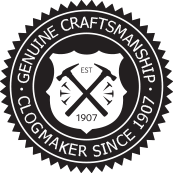Clogs were first made in Troentorp just outside Bastad over a hundred years ago in 1907. The small Swedish clog factory was started by August Johansson who had spent the previous 8 years learning his trade from a local cobbler in the Bastad area. Over the years the production process developed and in 1942 Augusts sons, Börje and Stig took over the clog factory.
Since 1907 around 15 million pairs of clogs have been made and while many improvements and changes have been made throughout the years we still remain true to the heritage established by August.
Since the initial workshop at the beginning of the 20th century, through the swinging 60s, up until this moment, Troentorp has held on to the unique craftsmanship methods developed over the decades.
Our especially developed Original and Ideal soles, lasting technique and nailing process give our footwear its characteristic look and comfort. The same craftsmanship and passion are still used in each and every pair of clogs that we make today.
Clogs nailed to last!

The founder of Troentorp Toffel August Johansson is born.
August finds himself interested in making clogs: How do you make them? Would people in the Båstad area like wooden clogs? Is there anyway to make these wooden shoes more comfortable and practical? Eager to learn, he starts looking for an experienced cobbler to learn from. He gets a chance to learn when he moves to Kringelstad, a town with a clog cobbler. August now works as a farmhand during the day and goes and helps the cobbler in the evenings. The master cobbler, impressed by August’s enthusiasm and skills, eventually offers him a job in the clog workshop.
August has learnt the craftsmanship and is ready to start his own business. He rents premises in Troentorp outside Båstad. Making wooden clogs is hard work and he quickly realizes that he can improve the production process in order to make life in the workshop easier: Firstly, he develops a new planer to make the rough wood work easier. The next step is a new homemade bandsaw. Finally, a new wind powered lathe was built. The building was just 3 x 4 meter and was placed on a pole so it could rotate depending on the direction of the wind.
Why are the first Troentorp clogs made of wood? The wood protects the feet against the Båstad regions harsh weather. At this time wood is also easily available and cheap in Sweden.
Two years later the factory building is moved to our current location in Troentorp, Båstad.
August has enough of the unpredictable wind power and finds a replacement in a 2hp crude oil engine. The 2hp engine will be the workshop’s power plant until 1940.
The old oil engine is finally replaced with electricity.
August’s sons, Börje and Stig take over the Troentorp clog business.
The brothers hire the first fulltime employee at Troentorp, Sven Persson.
Extensions and conversions are made to the factory building in order to increase production capacity.
Troentorp introduces a new wedge heel wooden bottom. This will be the foundation for our Original bottoms that are still in production today.
A disastrous fire burns the factory to the ground. Börje and Stig work day and night to restore the factory. They take the chance to rethink and develop the manufacturing process. To improve quality they decide the wood should be worked dry rather than wet. They introduce a drying facility, where they allow the wood to dry properly before making the bottoms. The lowering of moisture content in the wood in the pre-production phase leads to big quality improvements.
A new boiler room and kiln is installed to improve the wood drying process. Production is increased to 104,000 pairs of clogs per year.
The Wright clogs (Model 166) with a tailored weave across the clogs' front are created.
The Audubon Clogs (Model 867) with laces are designed and go into production.
A new premise for nailing the clogs is built and production is increased to 244,000 pairs of Troentorp clogs per year.
The Mariah clog (Model 373) sandal is designed and sees the Båstad sunlight for the first time.
A new sawmill building, a new kiln for drying the wood and a new machine hall for making the wooden clog bottoms are put in place.
Troentorp Durer (Model 675) and Raphael (Model 062) clogs are developed and enter into production.
Engineer Torsten Thomasson is hired as CEO which allows Börje and Stig to focus on improving production techniques and working on inventions to ease the workload of the employees as well as improving quality.
The 150 craftswomen’s and craftsmen’s passion coupled with many years of hard work results in Troentorp’s peak of production: around 500,000 pair of clogs are made per year. Clogs leaving the Båstad region are sold to over 15 different countries. By this time our clogs have become famous both in Sweden and abroad. This is also the year the Mary Jane (Model 077) Clog sandals are designed.
The Rembrandt clogs (Model 082) and O’Keefe (Model 087) are created. At this point the demand for wooden clogs is weakened and both production and the number of employees are reduced.
Our popular Ideal bottoms are developed.
The closed back clog, Van Gogh (Model 999) is developed. We also start making our steel-toe clogs: Picasso (Model 5700).
The Four Star Professional (The Chef) and the Five Star Professional clogs (Models 830 and 840) go into production.
Our Penny (Model 115) and Nelly (Model 707) clog sandals are created.
Our Lisa clog sandals (Model 111) are designed.
We open our new factory in Bosnia & Herzegovina.
Christer Wilhemsson and Kåge Johansson both retired. Between them they had more than 90 years of experience in the factory. They had together been in charge of production and training new employees over the last decades. Without them Troentorp would not be what it is today.
Our best selling clog boots Turner (Model 123) and Morris (Model 124) are designed.
We start making shearling clog boots with warm sheepskin lining.


